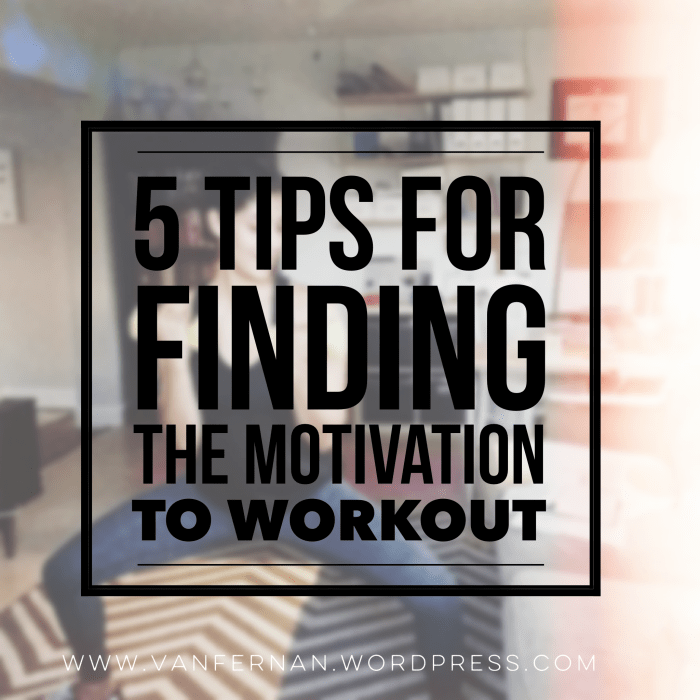
So, you want to conquer Mount Fitness? Excellent! But let’s be honest, sometimes the sheer thought of another burpee feels like scaling Everest in flip-flops. This isn’t about becoming a superhuman overnight; it’s about finding your
-personal* fitness Everest and conquering it one mindful step (or lunge) at a time. We’re ditching the grueling boot camp mentality and embracing a smarter, funnier, and more sustainable approach to fitness motivation.
Prepare for a journey filled with laughter, self-discovery, and maybe even a celebratory slice of (healthy) cake.
This guide tackles everything from setting realistic goals (goodbye, unrealistic New Year’s resolutions!) to finding your inner cheerleader (even if that cheerleader is a slightly sarcastic voice in your head). We’ll explore the science of motivation, design personalized workout plans that don’t feel like torture, and delve into the crucial role of nutrition (because abs are made in the kitchen, or so they say!).
We’ll even help you navigate the mental game, because fitness is as much a mental marathon as a physical one.
Setting Realistic Goals
Let’s face it, leaping from zero to marathon runner overnight is about as likely as finding a unicorn in your gym bag. Setting realistic fitness goals is the cornerstone of a successful and enjoyable fitness journey. Without them, you’re essentially wandering aimlessly in a gym filled with tempting (and potentially injury-inducing) equipment. Think of it as navigating with a map instead of a blindfold.
SMART goals are your secret weapon in this battle against fitness frustration. SMART stands for Specific, Measurable, Achievable, Relevant, and Time-bound. Let’s break down each component, because vague aspirations rarely translate into sweaty triumphs.
SMART Goal Breakdown
Crafting SMART goals isn’t rocket science (unless your goal
-is* rocket science, in which case, good luck!), but it does require a bit of thoughtful planning. The following steps will guide you through the process, ensuring your goals are as clear as a perfectly sculpted bicep.
- Specific: Instead of “get in shape,” aim for “run a 5k in under 30 minutes.” The more detailed your goal, the easier it is to create a plan to achieve it.
- Measurable: How will you know if you’ve succeeded? Track your progress using a fitness tracker, a journal, or even a simple spreadsheet. For the 5k goal, measuring progress would involve tracking your running distance and time over several weeks.
- Achievable: Be realistic! If you’ve never run before, aiming for a sub-30-minute 5k in a month is probably overly ambitious. Start with smaller, achievable goals that build confidence and momentum.
- Relevant: Does this goal align with your overall fitness aspirations and lifestyle? A goal to bench press 300 pounds might be irrelevant if you’re primarily focused on improving your endurance for hiking.
- Time-bound: Set a deadline. This creates a sense of urgency and helps you stay focused. For the 5k goal, you might set a deadline of three months.
Sample Fitness Plans Incorporating SMART Goals
Here are sample plans showcasing SMART goals tailored to different fitness levels. Remember, these are just examples; adjust them to fit your individual needs and preferences.
| Fitness Level | SMART Goal | Plan |
|---|---|---|
| Beginner | Walk for 30 minutes, 3 times a week for 4 weeks. | Start with 15 minutes, gradually increasing duration and frequency. Focus on comfortable pace and proper form. |
| Intermediate | Complete a 10k run in under an hour within 8 weeks. | Create a training schedule that incorporates interval training, long runs, and rest days. Monitor heart rate and pace. |
| Advanced | Increase maximum bench press by 20 pounds in 12 weeks. | Implement a structured weightlifting program with progressive overload, focusing on proper technique and adequate rest. |
Common Fitness Goal Pitfalls and Strategies to Avoid Them
Even the most well-intentioned fitness plans can fall apart. Knowing the common pitfalls can help you stay on track.
- Unrealistic Expectations: Avoid setting goals that are too ambitious too quickly. This often leads to discouragement and burnout.
- Lack of Planning: A vague goal is a recipe for failure. Create a detailed plan outlining how you’ll achieve your goal.
- Inconsistent Effort: Consistency is key. Regular exercise, even in small doses, is more effective than sporadic bursts of intense activity.
- Ignoring Rest and Recovery: Your body needs time to recover. Adequate rest prevents injury and promotes muscle growth.
Tracking Progress and Adjusting Goals
Regularly monitoring your progress is crucial. It allows you to celebrate successes, identify areas needing improvement, and make necessary adjustments to your goals. Think of it as a feedback loop – your body is telling you what works and what doesn’t. Don’t be afraid to tweak your plan along the way. Flexibility is your friend in the fitness world.
For example, if your initial goal was to run a 5k in under 30 minutes but you’re consistently falling short, you might adjust your goal to focus on improving your running pace over a shorter distance first, before tackling the 5k again. This allows you to maintain motivation while still making progress.
Finding Your Motivation
Let’s face it, the path to fitness nirvana isn’t paved with protein shakes and rainbows. It’s a bumpy road littered with tempting donuts and the siren song of the couch. But fear not, aspiring fitness gurus! Finding the fuel to keep your engine running is entirely possible, and we’re about to unlock the secrets to a motivation makeover.
We’ll explore the inner workings of your drive, tackle those pesky roadblocks, and customize a motivation plan just for you.Finding the right kind of motivation is key to sticking with your fitness goals. Some people are driven by external rewards (extrinsic motivation), while others find their inspiration from within (intrinsic motivation). Both are powerful, and the best approach often involves a blend of both.
Intrinsic and Extrinsic Motivation Techniques
Intrinsic motivation taps into your inner wellspring of “I want to” – the pure joy of movement, the satisfaction of progress, the feeling of accomplishment. Think of the runner’s high, the endorphin rush, or the sheer pride in fitting into those jeans you thought were lost forever. Extrinsic motivation, on the other hand, relies on external rewards – think new workout gear, a celebratory dinner after reaching a milestone, or even the simple satisfaction of ticking off items on your fitness to-do list.
A smart strategy combines both: the internal satisfaction of a great workout, boosted by the external reward of a new pair of running shoes.
Common Barriers to Maintaining Fitness Motivation and Their Solutions
Life has a knack for throwing curveballs, and fitness motivation is no exception. Common barriers include time constraints, lack of energy, feeling overwhelmed, and simply losing that initial spark. But don’t despair! Solutions exist. For time constraints, try scheduling workouts like important appointments. For low energy, start small and gradually increase intensity.
Feeling overwhelmed? Break down your goals into smaller, more manageable steps. And if the initial fire fades, try a new activity or find a workout buddy to reignite your passion.
Motivational Strategies for Various Personality Types
The key to long-term fitness success is finding a strategy that aligns with your personality.
For example:
- The Planner: Thrives on structure. Detailed workout schedules, meticulously tracked progress, and long-term goals are essential.
- The Free Spirit: Prefers spontaneity and variety. Experimenting with different activities, avoiding rigid routines, and focusing on fun are key.
- The Competitor: Driven by challenges and achievements. Setting personal bests, participating in competitions, and tracking progress against others can be highly motivating.
- The Social Butterfly: Finds motivation in group settings. Joining fitness classes, finding a workout buddy, or participating in team sports can provide encouragement and accountability.
Building a Supportive Fitness Community or Finding a Workout Buddy
Surrounding yourself with like-minded individuals can significantly boost your motivation. A workout buddy provides accountability, shared goals, and mutual encouragement. Consider joining a fitness class, participating in group fitness challenges, or even connecting with others online through fitness forums or social media groups. Remember, shared struggles and triumphs make the journey far more enjoyable and sustainable. Finding someone with similar goals and fitness levels can foster a supportive and motivating environment.
A buddy system can also add an element of friendly competition, pushing you both to achieve more.
Designing a Personalized Workout Plan

So, you’re ready to ditch the couch potato lifestyle and embrace your inner fitness guru? Fantastic! But before you leap into a grueling routine that leaves you feeling more like a deflated balloon than a sculpted Adonis, let’s craft a workout plan that’s as unique as your fingerprint (and hopefully less smudgy). Remember, a personalized plan is key to avoiding injuries and sticking with your fitness journey.
Think of it as your bespoke fitness suit – tailored to fit you perfectly.Creating a personalized workout plan involves considering your fitness level, goals, available time, and preferred activities. It’s about finding a balance between challenging yourself and avoiding burnout. We’ll cover a sample schedule, bodyweight exercises, routines for various goals, and the crucial role of rest.
A Sample Weekly Workout Schedule
A balanced workout routine should incorporate cardio, strength training, and flexibility exercises. This sample schedule provides a good starting point, but remember to adjust it based on your individual needs and preferences. Consistency is more important than intensity in the beginning.
| Day | Workout Type | Example Activities |
|---|---|---|
| Monday | Strength Training (Upper Body) | Push-ups, pull-ups (or assisted pull-ups), dumbbell rows, overhead press (using water bottles or resistance bands) |
| Tuesday | Cardio | 30 minutes brisk walking, jogging, cycling, or swimming |
| Wednesday | Rest or Active Recovery | Light stretching, yoga, foam rolling |
| Thursday | Strength Training (Lower Body) | Squats, lunges, calf raises, glute bridges |
| Friday | Cardio | 30 minutes of your preferred cardio activity |
| Saturday | Flexibility and Core | Yoga, Pilates, planks, side planks, crunches |
| Sunday | Rest or Active Recovery | Rest or light activity like a leisurely walk |
Bodyweight Exercises for Home Workouts
No gym membership? No problem! Bodyweight exercises are incredibly effective and require no equipment. These exercises are perfect for beginners and can be easily modified to increase difficulty as you get stronger.
- Squats: Works legs and glutes. Imagine you’re sitting in a chair without actually sitting.
- Push-ups: Targets chest, shoulders, and triceps. Modify by doing them against a wall or on your knees.
- Lunges: Works legs and glutes. Focus on maintaining good form to avoid knee injuries.
- Plank: Strengthens core muscles. Hold the position for as long as you can maintain proper form.
- Burpees: A full-body exercise that combines squats, push-ups, and jumps. A great calorie burner!
Workout Routines for Specific Fitness Goals
Different goals require different approaches. Here are some examples:
Weight Loss
Focus on a combination of cardio and strength training. Cardio burns calories, while strength training builds muscle mass, which boosts metabolism. Aim for at least 150 minutes of moderate-intensity cardio per week, along with strength training twice a week.
Muscle Gain
Prioritize strength training. Focus on compound exercises (those that work multiple muscle groups) and progressively overload (gradually increase the weight or resistance). Ensure adequate protein intake to support muscle growth.
Endurance
Concentrate on consistent, long-duration cardio workouts. Gradually increase the duration and intensity of your workouts over time. Include cross-training to prevent overuse injuries.
The Importance of Rest and Recovery
Rest isn’t just a luxury; it’s a necessity. Your muscles repair and rebuild themselves during rest, allowing you to get stronger and avoid injuries. Aim for at least one or two rest days per week, and listen to your body – if you’re feeling overly fatigued, take an extra day off. Remember, “No pain, no gain” is a myth.
Smart pain, smart gain is the mantra! Proper rest is your secret weapon in this fitness game.
Nutrition for Fitness Success
Fueling your body for fitness isn’t about deprivation; it’s about strategic nourishment. Think of your body as a high-performance machine – you wouldn’t put low-grade fuel in a Ferrari, would you? Proper nutrition is the key to unlocking your fitness potential, helping you build muscle, increase energy levels, and recover faster. Let’s ditch the fad diets and explore a sustainable approach to eating for optimal performance.
A Sample Daily Meal Plan
This sample meal plan provides a balanced intake of macronutrients and micronutrients to support a moderately active lifestyle. Remember, individual needs vary based on factors like activity level, body composition, and overall health. Consult a registered dietitian or nutritionist for personalized guidance.
| Meal | Food | Approximate Macronutrient Breakdown (adjust based on your needs) |
|---|---|---|
| Breakfast | Oatmeal with berries and nuts, a scrambled egg | Carbohydrates: 40%, Protein: 30%, Fat: 30% |
| Lunch | Grilled chicken salad with mixed greens, avocado, and a light vinaigrette | Carbohydrates: 30%, Protein: 40%, Fat: 30% |
| Dinner | Baked salmon with roasted vegetables (broccoli, sweet potatoes) | Carbohydrates: 30%, Protein: 40%, Fat: 30% |
| Snacks | Greek yogurt with fruit, a handful of almonds | Variable, focus on protein and healthy fats. |
The Importance of Hydration
Water isn’t just a beverage; it’s the lifeblood of your workout. Dehydration even slightly can significantly impact your performance, leading to fatigue, muscle cramps, and reduced endurance. Think of it like this: your muscles are mostly water, and they need it to function optimally. Adequate hydration helps regulate body temperature, transport nutrients, and remove waste products. Aim for at least eight glasses of water per day, and more if you’re exercising intensely.
Listen to your body – thirst is a late sign of dehydration.
The Impact of Macronutrients on Fitness
Macronutrients – carbohydrates, proteins, and fats – are the building blocks of your diet and play crucial roles in fitness.Carbohydrates provide the primary fuel source for your workouts, particularly high-intensity activities. Think of them as the gasoline for your engine. Choose complex carbohydrates like whole grains, fruits, and vegetables over refined sugars.Proteins are essential for building and repairing muscle tissue.
They’re the bricks and mortar of your muscles. Include lean protein sources like chicken, fish, beans, and lentils in your diet.Fats are often misunderstood, but healthy fats are vital for hormone production, nutrient absorption, and overall health. Incorporate sources like avocados, nuts, seeds, and olive oil. Avoid excessive consumption of saturated and trans fats.
Benefits of Whole Foods and Minimizing Processed Foods
Whole foods, in their unprocessed or minimally processed state, are packed with nutrients and fiber. They offer a wealth of vitamins, minerals, and antioxidants that support overall health and fitness. Processed foods, on the other hand, are often loaded with added sugars, unhealthy fats, and sodium, which can hinder your fitness goals and contribute to weight gain. Making the switch to whole foods is a powerful way to improve your diet and boost your fitness results.
Imagine the difference between eating a whole apple versus apple juice – one is nutrient-dense, the other is largely sugar.
Tracking Progress and Staying Consistent

Let’s face it, the hardest part of fitness isn’t the workout itself – it’s the mental game of sticking with it. Consistency is key, and tracking your progress is like having a personal cheerleader (who also happens to be brutally honest). It helps you see how far you’ve come, identify areas needing improvement, and stay motivated when things get tough.
Think of it as your fitness journey’s very own highlight reel, complete with bloopers and triumphant moments.Tracking your workouts and nutrition isn’t about obsessive record-keeping; it’s about celebrating your wins and learning from your stumbles. A simple system can make a world of difference, and we’ll explore a straightforward method to help you stay on track.
A Simple Tracking System
Maintaining a fitness log is surprisingly satisfying. Seeing your progress visually helps cement your commitment. Here’s a simple table you can adapt to your needs. Remember, even a basic tracker is better than no tracker at all!
| Date | Workout | Duration | Notes |
|---|---|---|---|
| October 26, 2023 | 30-minute jog | 35 minutes (included a 5-minute cool-down!) | Felt great! Slightly sore quads. |
| October 27, 2023 | Strength training (upper body) | 45 minutes | Challenging but rewarding. Increased weight on bench press. |
| October 28, 2023 | Rest day | N/A | Enjoyed a long walk instead. |
Overcoming Setbacks and Maintaining Consistency
Life happens. Sometimes, you’ll miss a workout, overindulge, or feel completely unmotivated. The key is not to beat yourself up about it, but to view setbacks as temporary roadblocks, not road closures. Think of it like this: a single missed workout won’t derail your entire fitness journey any more than a single raindrop ruins a sunny day.Instead of dwelling on the missed workout, focus on getting back on track as soon as possible.
Forgive yourself, adjust your plan if necessary, and remember your “why.” What are your goals? Why did you start this journey in the first place? Reconnecting with your initial motivation can be incredibly powerful.
Reward Systems for Success
Rewards aren’t just about indulging in treats (although, a healthy celebratory treat can be a great motivator!). They should align with your goals and interests. Consider these ideas:
- Non-food rewards: A new workout outfit, a massage, a relaxing bath, a new book, a movie night.
- Small, healthy treats: A small piece of dark chocolate, a smoothie, a serving of your favorite fruit.
- Milestone rewards: A weekend getaway after reaching a significant weight loss goal, new workout equipment after completing a fitness challenge.
Remember, the reward should feel earned and celebrate your effort, not undermine your progress.
Utilizing a Fitness Journal for Reflection
A fitness journal goes beyond simply tracking workouts. It’s a space for self-reflection, allowing you to analyze your progress and identify patterns. Write down not only your workouts but also your feelings, challenges, and what you learned. This reflective practice is invaluable for long-term success. Did you find certain exercises particularly effective?
Were there times you felt exceptionally motivated? What were the circumstances? Identifying these patterns can help you optimize your routine and stay motivated.
Mental Wellness and Fitness
Forget the image of the perpetually grumpy gym rat; a healthy mind is the ultimate fitness accessory. The connection between mental and physical health is so strong, it’s practically a Gordian knot – you can’t really untangle one without affecting the other. A stressed-out mind can sabotage your workout, while regular exercise is a fantastic mood booster. Think of it as a two-for-one deal: stronger body, stronger mind.The benefits of prioritizing mental wellness extend far beyond simply feeling good.
It’s about optimizing your fitness journey for peak performance and sustainable results. Ignoring your mental health is like trying to build a house on a shaky foundation – eventually, the whole thing will crumble.
Mindfulness and Meditation Enhance Fitness Performance
Mindfulness and meditation aren’t just trendy buzzwords; they’re powerful tools for enhancing athletic performance. By focusing on the present moment, you improve body awareness, leading to better form, injury prevention, and increased efficiency during workouts. Studies have shown that regular meditation can reduce cortisol (the stress hormone), leading to lower resting heart rate and improved recovery times. Imagine yourself effortlessly gliding through your yoga flow, completely present and attuned to your body’s movements – that’s the power of mindfulness in action.
Strategies for Managing Fitness-Related Stress and Anxiety
Fitness goals, while inspiring, can also be a breeding ground for stress and anxiety. Setting unrealistic expectations is a common culprit. Instead of aiming for a drastic transformation overnight, focus on small, achievable steps. Celebrate every milestone, no matter how small. Another effective strategy is to cultivate a supportive community – whether it’s workout buddies, online forums, or a personal trainer.
Remember, you’re not alone in this journey. Sharing your struggles and celebrating your successes with others can make a world of difference. Visualizing success and practicing positive self-talk are additional tools to keep anxiety at bay. Imagine yourself confidently conquering that challenging workout; that positive visualization can significantly boost your confidence and reduce pre-workout jitters.
Cultivating a Positive Self-Image and Body Image
Let’s ditch the scales and embrace a more holistic view of fitness. Your worth isn’t defined by a number on the scale or the size of your clothes. Focus on how your body feels, not how it looks. Celebrate your strength, endurance, and progress, rather than focusing solely on aesthetics. Surround yourself with positive influences – people who celebrate your efforts and achievements regardless of your physical appearance.
Remember, progress, not perfection, is the name of the game. And remember those muscles you’ve built? They’re a testament to your hard work and dedication, a visual representation of your commitment to a healthier lifestyle.
Health Fitness: A Holistic Approach
Forget the all-or-nothing mentality! True health and fitness isn’t about picking one “best” method and sticking to it religiously (unless that method is eating copious amounts of chocolate – just kidding…mostly). It’s about finding a balanced approach that works foryou*, your body, and your sanity. This means considering various aspects of your well-being, not just the number on the scale or the size of your biceps.Different approaches to fitness offer unique benefits and drawbacks.
Consider CrossFit, a high-intensity workout that combines elements of weightlifting, gymnastics, and metabolic conditioning. It builds incredible strength and endurance, but the high-impact nature can increase the risk of injury if not done properly. Yoga, on the other hand, focuses on flexibility, balance, and mindfulness, offering stress relief and improved body awareness. While generally low-impact, it may not provide the same level of muscle building as CrossFit.
Pilates, emphasizing core strength and controlled movements, improves posture, stability, and body control. It’s a great option for rehabilitation and injury prevention, but might not provide the same cardiovascular benefits as other approaches. The key is understanding your goals and physical limitations before choosing a fitness style.
Regular Health Check-Ups and Consultations
Regular check-ups are not just for hypochondriacs; they are essential for proactive health management. These visits allow healthcare professionals to monitor your overall health, identify potential problems early, and provide personalized advice tailored to your fitness goals. A yearly physical, including blood work and any necessary screenings, gives you a baseline understanding of your health and allows for early detection of conditions like high blood pressure or high cholesterol, which can be exacerbated by intense fitness regimes.
Furthermore, consultations with healthcare professionals can help you understand the risks and benefits of different exercise approaches and modify your training plans based on your individual needs. For example, someone with pre-existing knee problems might benefit from a consultation with a physical therapist before starting a high-impact exercise program. Ignoring these crucial check-ups is like driving a car without regular maintenance – you might get away with it for a while, but eventually, something’s going to break down.
Common Health Concerns Related to Fitness and Mitigation Strategies
Injuries and overtraining are common pitfalls for fitness enthusiasts. Injuries, ranging from minor muscle strains to more serious fractures, can occur due to improper form, inadequate warm-ups, overexertion, or ignoring pain signals. Mitigation strategies include proper warm-up and cool-down routines, gradual progression of exercise intensity, listening to your body and resting when needed, and seeking professional guidance from trainers or physical therapists.
Overtraining, on the other hand, occurs when the body is subjected to excessive stress without adequate recovery. Symptoms include persistent fatigue, decreased performance, mood swings, and increased susceptibility to illness. Strategies to prevent overtraining involve incorporating rest days into your workout schedule, prioritizing sleep, managing stress levels, and listening to your body’s signals. Remember, pushing yourself is good, but pushing yourself
too* hard is a recipe for disaster.
Integrating Healthy Habits into Daily Life
Fitness is not just about hitting the gym; it’s about cultivating a holistic lifestyle that supports your overall well-being. Adequate sleep is crucial for muscle recovery, hormone regulation, and cognitive function. Aim for 7-9 hours of quality sleep each night. Stress management is equally important. Chronic stress can negatively impact your physical and mental health, hindering your fitness progress.
Incorporate stress-reducing activities like meditation, yoga, or spending time in nature into your daily routine. Finally, remember that nutrition is the cornerstone of fitness. A balanced diet rich in fruits, vegetables, lean proteins, and whole grains fuels your workouts and supports your body’s recovery. Think of it like this: your body is a high-performance machine; you wouldn’t put low-grade fuel in a Ferrari, would you?
Conclusive Thoughts
Ultimately, fitness motivation isn’t about achieving some unattainable ideal; it’s about building a sustainable, enjoyable relationship with your body and your well-being. It’s about celebrating small victories, learning from setbacks, and remembering that progress, not perfection, is the name of the game. So, lace up those sneakers, grab a water bottle (maybe a fun one!), and get ready to embark on this exciting adventure.
Remember, you’re not just getting fitter; you’re becoming a more awesome, healthier, and happier version of yourself – and that’s something worth celebrating!
Expert Answers
What if I don’t see results immediately?
Patience, grasshopper! Fitness is a marathon, not a sprint. Celebrate small wins and remember that consistency is key. If you’re not seeing results, reassess your plan and seek professional advice if needed.
How do I stay motivated when life gets in the way?
Life happens! Build flexibility into your plan. Short, effective workouts are better than no workouts. Find a workout buddy for accountability, and remember to forgive yourself for setbacks.
What’s the best way to track my progress?
Find a system you enjoy! It could be a fitness app, a journal, or even a simple spreadsheet. The key is consistency, so choose something you’ll actually stick with.
Is it okay to take rest days?
Absolutely! Rest days are crucial for muscle recovery and injury prevention. Don’t feel guilty about taking a break; your body will thank you.





